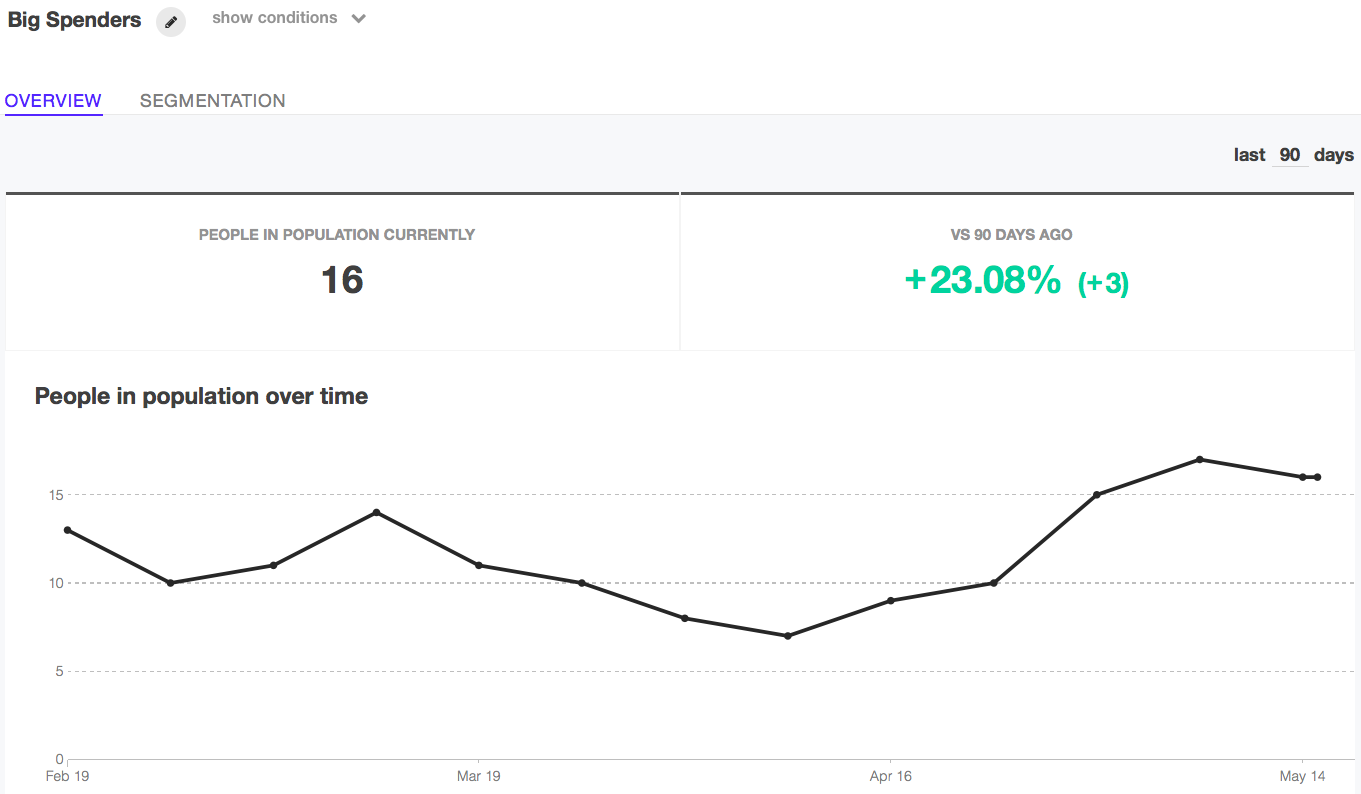A few weeks ago we released Populations, a tool to help marketing & product teams track key groups of people across their growth cycle. And just last week, our CEO Brian Kelly announced the new phase of Kissmetrics – Customer Engagement Automation (CEA).
CEA combines our powerful behavioral analytics with engagement tools to boost acquisition and user engagement in key areas of the funnel. It’s a great choice for SaaS and e-commerce teams.
Here’s five Populations e-commerce marketers can set up to monitor key parts of the buyer journey.
1. First-Time Buyers
A first time buyer is a fresh chance to gain a new repeat purchaser. The more of these coming in, the more you can convert to repeat purchasers for life. Hence, the better your business will be.
Here’s a hypothetical Population that’s tracking first time buyers.
This is looking at the first time buyers you’ve had in the last month. If this were your data, you’d want to keep this Population increasing – especially if you can maintain the 30%+ when compared to 90 days ago.
You can contact each person in this Population by scrolling down and clicking this button:
Click that and you’ll get a list of email addresses (or however you identify people). You can also use these people in a Campaign and send an email to incentivize them to repurchase:
You can then target these people with an email offering a coupon, free shipping, new product announcement, etc. Call the campaign a success when they Purchase:
We’ve created this video if you’d like to learn more about our Campaigns feature:
2. One & Done Buyers
This is one Population you’ll want to continually reduce in size.
You can set up a Population to basically say, “show me all the people that purchased at least 6 months ago and have not purchased since.”
Here’s an example for that Population:
If this was your data, you’d have to compare it to the total number of purchasers you’ve had. If, for example, you’ve had 50,000 customers purchase over the lifetime of the company, you know this is really good data because only a small percentage don’t come back to purchase. On the other hand, if you’ve only had 500 total purchasers, you’d know you were in trouble with getting customers to come back and repurchase.
3. Big Spenders
Your big spenders are those that are the most valuable. They spend more than all your other customers. Obviously, you’ll want to retain these customers and know if you’re getting more or fewer of them.
To get some use out of this Population, you’ll first need to have some context. You’ll need to know your average purchase value and ideally the average amount of times people purchase during a specific time period.
Let’s say most people spend $30 on every purchase and purchase twice every 3 months.
To find your big spenders, you’ll have to have a Kissmetrics property that records purchase amount. Once you have that, you can create a population like this:
Let’s view that Population:
You’re up 3 customers from 90 days ago, so we can’t complain much. If we’re also up 23% in orders compared to 90 days ago, we know we’re doing really well.
From here, we can do the same thing we did with our first time buyers. We’ll create a Campaign and incentivize these big spenders to keep coming back to us. Get enough of these big spenders coming back, and we’ll increase our overall lifetime value per customer.
4. Monthly Repeat Buyers
Repeat buyers are the lifeblood of an e-commerce company. No store can survive long solely on first-time buyers. Like SaaS companies, retaining as many customers as possible is crucial.
This shows us that it has held steady, and increased about 2% compared to 90 days ago.
5. Browsers
These are the lurkers, your comparison shoppers, and the ones who overthink every purchasing decision. They visit your site routinely but never seem to pull the trigger to purchasing.
You can set a Population to say “find me all the people that have visited at least 10 times the past 30 days but have not purchased.”
The number of people in this Population is down slightly from 90 days. This, obviously, means it’s headed in the right direction. You can decrease the number of browsers by having special offers, increasing conversion rates, lowering prices (for those that price shop) or getting more products in stock that those browsers are looking for.
Use Populations to Track People Across the Buyer Journey
Populations makes it easy to see how groups change over time along with the changes in your marketing activities. Identify the weak points and take action with Campaigns – all within Kissmetrics.
If you’re already a Kissmetrics user, sign in today and Populations will be ready for you. If you’re not a user and would like to learn more about Kissmetrics, you can request a demo.
About the Author: Zach Bulygo (Twitter) is the Blog Manager for Kissmetrics.
Powered by WPeMatico










